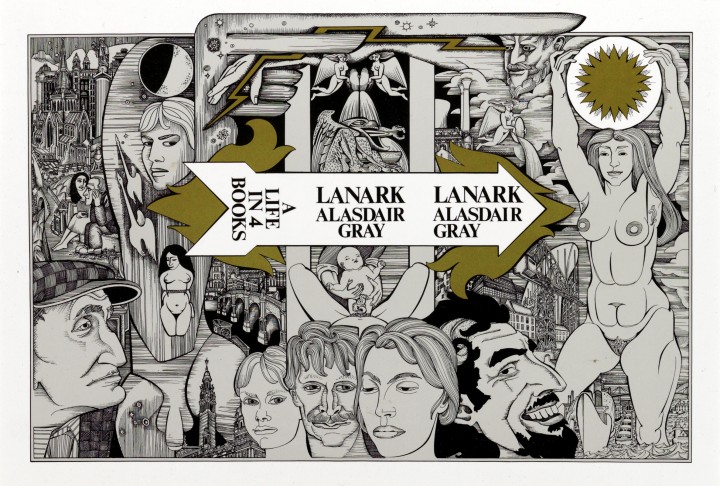Scottish Art News
Latest news
Magazine
News & Press
Publications
Let Glasgow Flourish
By Greg Thomas, 29.09.2022

Alasdair Gray, who died in 2019, was part of a generation of writers who gave Glasgow new literary life during the late twentieth century. An exhibition at the Hunterian documents the development of his intricate and obsessive masterpiece about the city, Lanark, published in 1981.
Lots of inhabitants of Glasgow will have some passing familiarity with Alasdair Gray’s visual art. His murals are dotted around the cityscape, with their teeming scenes of civic life and rows of faces – often curiously affectless, sphinx-like – staring back from between sharply outlined planes of colour. I’ve sometimes found an anxiety-inducing intensity in the detail and oddness of Gray’s work, but it was created from a position of love for his home city and country: a desire to see “Glasgow Flourish,” as one of the bookplates included in the present exhibition at the Hunterian has it, citing the city’s motto.
The maze-like pen drawings which Gray produced for the covers of Lanark: A Life in Four Books and its subsections – reproduced in silkscreen – indicate not only Gray’s characteristic visual style (with its touches of visionary Blake, louche Beardsley, and others) but his status as a true polymath, enclosing as they did a surreal, dystopian literary masterpiece. Lanark starts with its protagonist Lanark having just arrived in a strange city, ‘Unthank’, a kind of mirror-realm of Glasgow plagued by darkness and disease. In between descriptions of the city in the first and fourth books is a sort of anti-bildungsroman telling the life story of a man called Thaw, a poor Glaswegian whose precocious strangeness alienates him from peers and, more importantly, women, and who eventually drowns himself.
It’s difficult not to read Thaw as an analogue for Gray, although the author writes himself into the text more explicitly later on, explaining to Lanark the purely fictive nature of the universe he inhabits: “some worlds are made of atoms but yours is made of tiny marks marching in neat lines.” Such self- reflexive flourishes indicate the wormhole-like depths of imagination from which this book emerged over three decades. A series of notebooks on display at the Hunterian, filled with handwritten passages of narrative, chapters lists, and sketches, detail Lanark’s development from the 1950s onwards. A book of incomings and outgoings suggests Gray’s financial precarity during the writing process.
 (1920-2010), 2003-04..jpg) Alasdair Gray, Portrait of EM (Edwin Morgan) (1920-2010), 2003-04. The Hunterian, University of Glasgow. Courtesy The Alasdair Gray Archive.
Alasdair Gray, Portrait of EM (Edwin Morgan) (1920-2010), 2003-04. The Hunterian, University of Glasgow. Courtesy The Alasdair Gray Archive.
In a second room, a small selection of pictures alludes to the wider scope of Gray’s work and life. Particularly engaging is a 2004 portrait of the poet Edwin Morgan, whose financial support helped Gray to finish Lanark. Morgan is shown against a deep blue, futuristic city skyline: the two writers were united in their quest to reinvent Glasgow in the cultural imagination as a great, future-facing metropolis, as the following passage from Lanark, included in one of the notebooks, suggests:
“Glasgow is a magnificent city,” said McAlpin. “Why do we hardly ever notice that?” “Because nobody imagines living here....think of Florence, Paris, London, New York. Nobody visiting them for the first time is a stranger because he’s already visited them in paintings, novels, history books and films. But if a city hasn’t been used by an artist not even the inhabitants live there imaginatively.”
What do we learn about Lanark from this show? For those well-versed enough in the history of the book, the vitrines of ephemera might offer some compelling new detail. For those approaching from a position of general interest, it provides a somewhat cursory introduction to both the book and to Gray’s life and oeuvre. But there is enough here, at least, to suggest his significance not only amongst his Scottish modernist peers but within a lineage of visionary artist-writers stretching back to Blake: a startling, truly strange talent.
Alasdair Gray's Lanark: A World Made on Paper is exhibited at The Hunterian until 2 October




